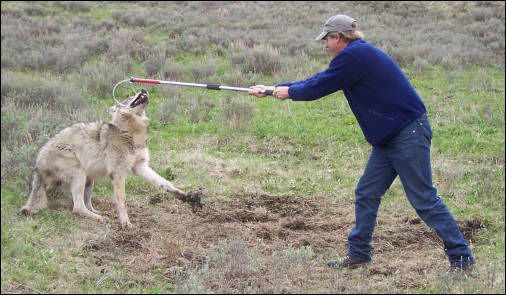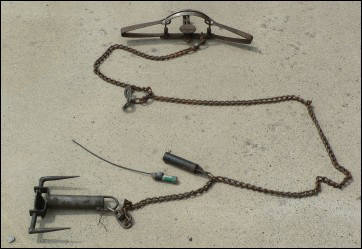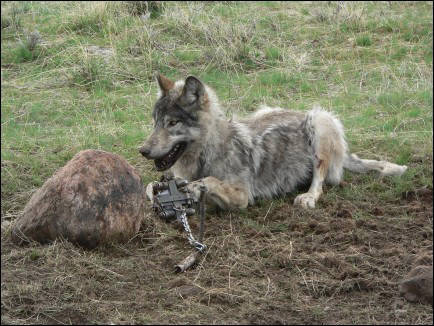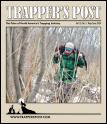TRAPPER'S POST
Exclusively Trapping
By Bob Noonan
July/August 2012 issue
Copyright 2012 by Trapper's Post. All rights reserved. No part of this article may be reproduced or transmitted in any form or by any means, electric or mechanical, including right clicking images, copying text, print screen, etc., without permission in writing by the publisher.
Mike Ross snare poling a trapped wolf, prior to putting a radio collar on it. This trap was staked solid.
The delisting of the Rocky Mountain and Western Great Lakes populations of gray wolves has opened up new trapping opportunities. As of this writing (May 1), Wisconsin and Idaho already have gray wolf trapping seasons, Minnesota and Montana are on the verge of approving one, and Wyoming is close to categorizing wolves as predators in a large portion of the state, which will make trapping them legal for anyone at any time of the year.
One difference between wolves and coyotes is that while coyotes can be skittish and hesitant to work a set, wolves are bold and curious, and if they’re interested in the set they go right in and work it.
A wolf pelt is a magnificent trophy, and many trappers will be trying for the largest canine in North America. What methods and equipment are best for wolf trapping in conditions besides the snow and cold of Canada and Alaska? The best people to ask are the biologists and trappers who have trapped thousands of them for the past 20 years or so, for research purposes.
Mike Ross, 49, is the Wolf Specialist for the State of Montana’s Department of Fish, Wildlife, and Parks. In that capacity he has personally trapped, and been involved in trapping, many hundreds of wolves for research, fitting them with radio collars and releasing them.
Ross is dealing with large western wolves that range from 80-120 lbs, and his preferred trap, and the one used by other researchers as well as the USFWS, is the #7 double longspring made by the Livestock Protection Company, from Alpine, Texas. It’s basically a modern version of the old Newhouse #14 wolf trap; it has 6 7/8-inch jawspread, thick, rounded cast jaws with a wide offset, and teeth.
Researchers intending to release animals unharmed want as little foot damage as possible, and it’s interesting that a toothed foothold with offset jaws is considered by many to be the safest capture tool for large, powerful animals. The teeth, which are not in the true sense teeth but actually rounded, blunt pegs, keep the animal’s foot from sliding between the jaws, which prevents cutting; any small puncture wounds these teeth make allow fluid to leak out, which prevents swelling; and the offset jaws allow blood circulation. The small tooth punctures apparently heal quickly. Ross says released wolves run off on all fours, and he sees them frequently afterwards from a plane while monitoring them, and they do not limp or favor the trapped foot. They go on to kill game and livestock, and raise pups, as successfully as other wolves.
It’s ironic that the antis raise such an outcry about the supposed horrific cruelty of toothed steel traps, when the wolves they claim to love so much were originally trapped and released with them, and the traps allow ongoing, essential research.
He says there are real similarities between coyote trapping and wolf trapping. The usual sets are used: dirt holes, flat sets, and scent posts. Any preferred coyote lure seems to work. His personal favorites are Carman’s Canine Call, and John Graham’s (Fur Country Lures) Deception, a coyote gland lure. He generally uses only gland lure, urine, and droppings, never bait, to avoid catching grizzlies, which can destroy a trap, or, worse, be held and have to be released.
Wolves are great travelers of roads and trails. Because a lot of research trapping is done on public lands along these travel ways, traps are usually attached to drags so the animal can get out of sight. The trap is attached to 8 feet of twist link machine chain, and the drag weighs 4 lbs. and has pivot prongs.
Wolves fight a trap hard, lunging and chewing it, and if a trap isn’t well made they’ll take it apart. All drag and chain connections are welded, not clamped, to withstand the abuse. This helps with grizzlies, too; ideally, you want them to pull out before they break something.
Ross dyes his traps but doesn’t wax them, because much research trapping is done in summer and early fall, and wax can melt in the heat. He does a lot of coyote fur trapping, and follows the same clean setting techniques for wolves. He keeps the clean traps in a box, sets with rubber gloves, and uses a kneeling cloth.
One difference between wolves and coyotes is that while coyotes can be skittish and hesitant to work a set, wolves are bold and curious, and if they’re interested in the set they go right in and work it. They don’t circle it cautiously. On the other hand, if they’re not interested they go right by. They’re great travelers and cover a lot of distance, and it can sometimes be a real waiting game for them to pass by the sets. Ross uses metal screen pan covers, which allow traps to stay functioning for long periods without maintenance. He checks sets from a vehicle when possible and avoids walking near them unless the trap has been disturbed.
If wolves pass by sets it can be another long wait before they return to that location. For this reason Ross gang sets to a degree, to offer them different odors, although he tries to keep sets out of sight of each other. Usually only one wolf is caught per location, and it’s also typical to catch only one wolf out of a pack. But for research purposes that’s fine, since once the animal is radio collared the whole pack can be followed.
Trapped wolves do not do well in high heat. Ross puts a small transmitter, about 2 inches long and 1 inch in diameter, on the chain close to the drag. The transmitter emits 1 beat a second until it’s moved; it then emits 2 beats a second. Traps are checked visually in the morning, then with the transmitter at noon and at night, to release wolves as soon as possible.
Ross starts trapping in April and stops in mid-October. He targets adults, and in the spring and summer targets den areas and then pack rendezvous sites. If pups caught in summer are too small to put a radio collar on, pet locator chips are sometimes put in them. By September the young of the year weigh 50-60 lbs. and are big enough to wear a radio collar.
Western Great Lakes wolves tend to run a bit smaller, averaging from 60-90 lbs. Researchers and predator control agents there sometimes use the slightly smaller Livestock Protection Company #4 double longspring, which has a 6 3/8-inch jawspread and cast offset jaws. This trap does not have teeth.
There are also effective coilspring wolf footholds on the market, among them the Sterling MJ-800 and the MB-750.
Trappers who can put the steel on coyotes undoubtedly have the basic skills to catch a wolf. But, even though some wolves have been held in coyote traps, don’t depend on coyote hardware to hold them all. Use traps built for this large, powerful predator.
Ross putting the collar on the now anesthetized wolf. Note the Livestock Protection Company #7 foothold to the right.
Ross’s standard foothold wolf gear. The double staking hardware provides that option, and the transmitter fits in the round sleeve near the drag.
A wolf caught in a Sterling MJ 800 Wolf Trap.
or wolves he wants the pan center a minimum of 12-14 inches back from the attractor. There should be a minimum of 6-8 lbs. pan tension, not only to keep smaller animals out, but to prevent toe catches on the wolves.
Trapper's Post
Article Archives
Trapper's Post
Article Archives

















